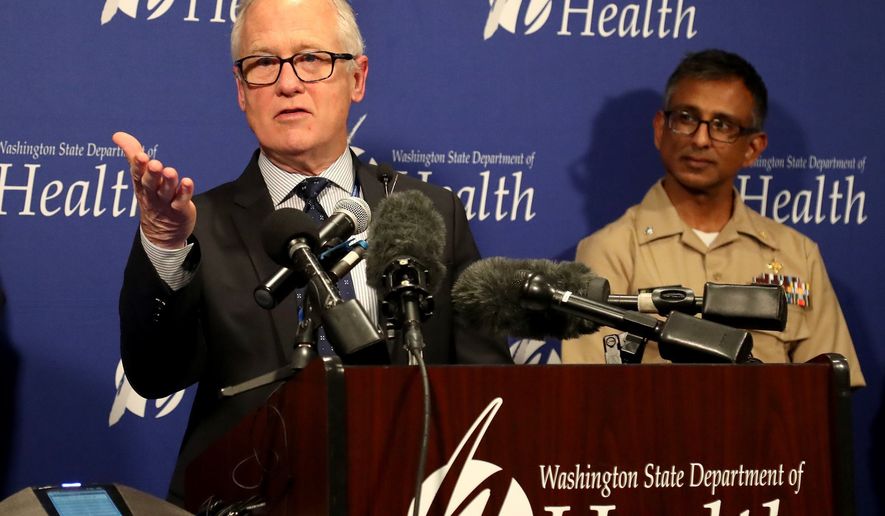Federal health officials confirmed Tuesday the first U.S. case of a mysterious, deadly virus that originated in China and has prompted worldwide travel warnings and screening protocols.
The Centers for Disease Control and Prevention on Tuesday reported on a case of the coronavirus in Washington state. The virus started in the central Chinese city of Wuhan late last year. Authorities in China reported Wednesday that it has sickened nearly 440 people and killed nine in their country. Six more illnesses have been reported in other Asian countries, in addition to the first American case.
“We know that today’s news is concerning,” Dr. Nancy Messonnier, director of the CDC’s National Center for Immunization and Respiratory Diseases, said Tuesday in the U.S. “How easily or sustainably this virus is spreading remains unknown.
“This is an evolving situation, and again we do expect additional cases in the United States and globally,” Dr. Messonnier told reporters.
The virus infected a man in his 30s who traveled indirectly from Wuhan and arrived in Seattle on Jan. 15, Washington state health officials said. He is reported to be in good condition and is being monitored at Providence Regional Medical Center Everett.
Although the coronavirus has entered the country, the CDC and other health agencies said the risk to the U.S. population is low.
“It is not surprising at all, given the degree of travel globally that we have and certainly between China and the United States, that certainly we would see a case,” said Dr. Anthony Fauci, director of the National Institute of Allergy and Infectious Diseases. “This is what happens when you have respiratory diseases that can present at first with no symptoms.”
The man infected with the coronavirus resides in Snohomish County, Washington. He traveled back to the U.S. before showing symptoms of the illness, state health officials said.
“No one wants to be the first in the nation in these types of situations, but these are the types of situations that public health and its partners train and prepare for. Because of this, everything has been going along quite smoothly,” said Dr. Christopher Spitters, an epidemiologist in Washington state.
Concerns about the pneumonialike illness grew in Asia and abroad Monday after a Chinese government specialist confirmed that the new coronavirus can spread from person to person — putting other countries and the U.S. on alert.
The CDC said it will start screening travelers at Hartsfield-Jackson Atlanta and Chicago O’Hare international airports this week.
Screenings began last week at John F. Kennedy International Airport in New York, San Francisco International Airport and Los Angeles International Airport.
Those three airports have screened more than 1,200 travelers. None has been found to have the virus or been referred to a hospital, the CDC said.
Six people had died and 291 had been infected with the coronavirus in China as of Tuesday, according to the National Health Commission. Exported cases have been reported in Thailand, Japan, South Korea and Taiwan.
A ’superspreader’?
The travel bustle of the Chinese Lunar New Year heightens the risk that the illness will spread. Chinese officials at airports and train stations checked passengers for symptoms, and medical-style face masks sold out in China on Tuesday.
Most of the confirmed cases of the coronavirus, and all of the deaths, have been reported in Wuhan and other parts of Hubei province. About 30 cases have been reported in other parts of China, including Beijing, Shanghai, the southern province of Guangdong and the eastern province of Zhejiang.
The virus was found to have infected 15 health care workers, suggesting it can be transmitted from person to person, the Wuhan Municipal Health Commission said.
Dr. Tedros Adhanom Ghebreyesus, director-general of the World Health Organization, will hold an emergency meeting Wednesday to determine whether China’s outbreaks should be deemed a global health crisis.
Public health officials are taking steps to quickly diagnose and develop treatments for the coronavirus. The National Institutes of Health are in the midst of developing a vaccine.
Because of the identification and release of the virus’ genetic sequence, the NIH was able to start crafting an experimental vaccine. Dr. Fauci said he expects the vaccine to be ready for a phase 1 clinical safety test within three months.
The NIH also is researching diagnostic tests, therapeutic treatments and monoclonal antibodies to address the outbreak.
Wuhan first reported the outbreak in late December and connected the virus to a large seafood market where many of those infected had worked or visited. Although transmission from animals to people had been reported, officials did not confirm the virus could spread from person to person until this week.
Dr. William Schaffner, an infectious disease specialist, said although the coronavirus undoubtedly spreads between humans, health professionals are unsure of how transmissible it is — whether it’s a “superspreader” or doesn’t transmit easily.
Distinguishing the coronavirus illness from common influenza will be challenging because symptoms are similar, he said.
The CDC sent 100 staffers to the airports in New York, Los Angeles and San Francisco on Friday and Saturday. Travelers who exhibit symptoms of illness will undergo testing.
Those who pose a potential risk will be placed in isolation at designated facilities for more testing and to prevent potential spread of the coronavirus. Getting results of diagnostic testing can take a day, the CDC said.
Common symptoms of the coronavirus include fever, cough, headache and a runny nose. Those with more dangerous types of coronavirus could experience shortness of breath, chills and body aches, the CDC said.
Coronaviruses are a large family of viruses that can infect people and animals. They are known to have circulated in camels, cats and bats. Animal coronaviruses can mutate to infect people and lead to human transmission, as seen with SARS (severe acute respiratory syndrome) and MERS (Middle East respiratory syndrome).
⦁ This article is based in part on wire service reports.
• Shen Wu Tan can be reached at stan@washingtontimes.com.




Please read our comment policy before commenting.